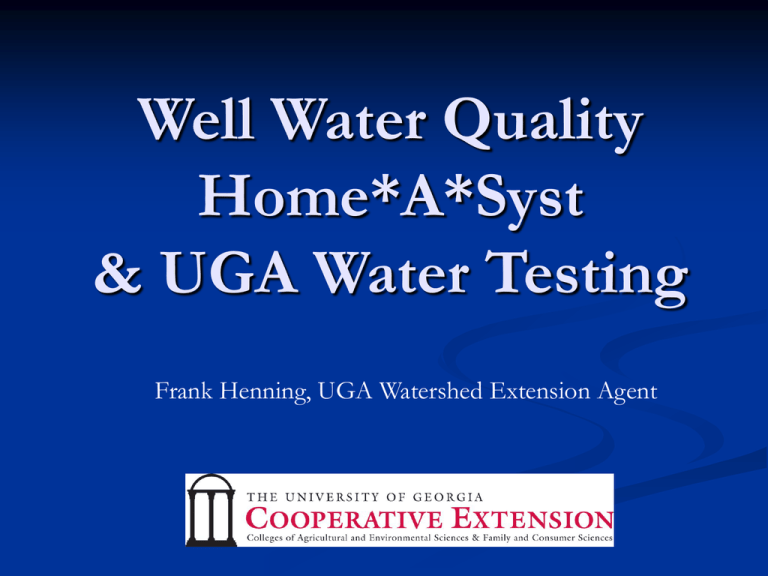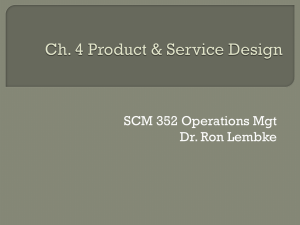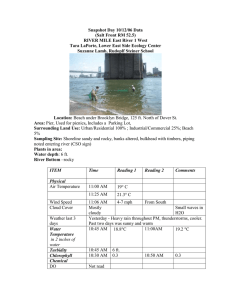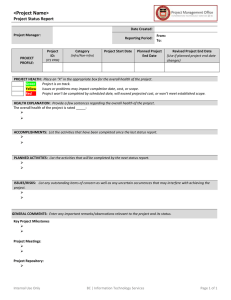Well Water Quality Home*A*Syst UGA Water Testing
advertisement

Well Water Quality Home*A*Syst & UGA Water Testing Frank Henning, UGA Watershed Extension Agent Potential Pollutants ex) Cleaning products, Gasoline, Oil, Pesticides, fertilizers, animal waste, septic systems… Easier to exclude pollutants than clean up!!!! Minimize contamination Maximize filtration/purification Direction and Rate of Movement Well Safe Drinking Water Who is protecting drinking water supplies? Who is testing for contamination? Using Home*A*Syst to Protect Your Water Supply Self Assessment: - a or b = few problems - c or d = potential problems - c or d Consider making changes to protect drinking water *Adapted from National Home*A*Syst Program & NCSU Home*A*Syst Publication 1. Where is your well located? a. Uphill from all pollution sources. No surface runoff reaches well. Surface water flows away from well. b. Uphill from most pollution sources. No surface water runoff reaches the well if drainage is working correctly. c. Downhill from many pollution sources, or one hazardous source. Some surface runoff may reach well. d. Settling or depressions around casing. Surface water runoff collects near well, or do not know. 2. Which best describes your well? 500 feet - Landfill 100 feet – Sewage , Animal waste, Chemicals and other potential contaminants. 50 feet – Building foundations, surface water a. All separation distances are greater than minimum requirements. b. Separation distances are at least ¾ the minimum c. Separation distances are a least ½ the minimum d. Some separation distances are less than ½ the minimum, or do not know. 3. How well does soil filter out pollutants? a. Fine textured soils (clay loam, silty clay) b. Medium textured soils (silt, silt loam) c. Medium or coarse textured soils with low organic matter d. Coarse textured soils (sands, sandy loam), or do not know. 4. How quickly does water reach your well? a. Water Table or fractured bedrock deeper than 50 feet. b. Water table or fractured bedrock deeper than 25 feet. c. Water table or fractured bedrock deeper than 10 feet d. Water table or fractured bedrock shallower than 10 feet, or do no know. 5.What is the condition of your well casing? a. No holes or cracks. Cap tightly secured. Screen vented b. No defects visible. Well is vented, but not screened. c. No holes or cracks visible. Cap easily removed. d. Holes or cracks visible. Cap loose or missing. Can hear water running; or do no know. 6. Are casing and grout deep enough? Which best describes the casing and grouting of your well? Cased and grouted to required depth. a. Cased and grouted below water table of well b. Cased, but not grouted. c. No casing. No grout; or do not know. 7. Is the well protected at the ground surface? Which best describes your wellhead? a. Casing extends more than 12 inches above surface and concrete pad extends 2 feet in all directions b. Casing above ground level and concrete pad 1 to 2 feet in all directions c. Casing above ground level and no concrete pad. d. Casing below ground level or in pit or basement and no concrete pad; or do not know 8. How old is your well? a. b. c. d. Less than 15 years old 15 to 30 years old 30 to 60 years old More than 60 years old; or do not know 9. Was your well drilled or dug? a. b. c. d. Drilled well Jetted or bored Driven (sand point) Dug; or do not know. Types of Wells Bored Large diameter (2 ft or larger) Shallow (uaually less than 60 ft) Vulnerable to surface influences Bacteria Chemicals Drilled Small diameter (usually 6 in) Deep (usually greater than 200 ft) Less susceptible to surface influences 10. Are you preventing backflow? a. Check valves are installed on all faucets with hose connections and there are no cross-connections between water supplies. b. Check valves are installed on some faucets with hose connections, or one check valve at well pump c. No check valves installed. Air gap maintained. d. No check valves installed. Air gap not maintained. Cross connections between water supplies; or do no know. 11. Do you have any unused wells? a. No unused, unsealed wells. b. Unused wells sealed and filled. c. Unused well on property more than 100 feet from supply well. Not capped or filled. d. Unused well less than 100 feet from supply well. Not capped or filled; or do not know. 12. Has your well been tested recently? a. Consistent, satisfactory water quality. Bacteria, nitrate, and other tests meet standards. b. Occasional deviation from standards with bacteria, nitrate, and other tests. c. Bacteria, nitrate and other tests often do not meet standards. d. No water tests done; or water discolored after rainstorms, or noticeable changes in color, clarity, odor or taste; or do not know. Indicator Organism Concept Correlated to the presence of pathogens Population large enough to isolate in small water samples (100 mL) Rapid Inexpensive Safety, not culturing pathogens Standard Bacteria Test Cost: ~$25 Total coliform Escherichia coli total coliform fecal coliform E. coli Pathogen Problems Numerous water borne pathogens Individual pathogen numbers may be too low to detect in a reasonable sized water sample Isolation and detection of some pathogens can take several days, weeks, or months Absence of one particular pathogen does not rule out the presence of another Primary Standard These are the elements and compounds that can cause adverse health effects when above the maximum contaminant level (MCL) set by the EPA. Cadmium (0.005 ppm) Chromium (0.005 ppm) Copper (1.3 ppm) Fluoride (4.0 ppm) Nitrate-N (10 ppm) Secondary Standards These are not generally considered threats to health, but cause nuisance problems such as staining, bad tastes and odors when above threshold levels. Aluminum (0.2 ppm) Chloride (250 ppm) Copper (1.0 ppm) Fluoride (2.0 ppm) Iron (0.3 ppm) Manganese (0.05 ppm) Sulfate (250 ppm) Total Dissolved Solids (500 ppm) % Above Standards (Statewide) 30.1 35 30 17 6.4 5.6 7.2 4.4 3.6 0.9 Low High pH pH Al Cu Pb Fe NO3 NO3 MCL AL 25 20 15 10 5 0 Basic Water Test ~$15 pH Hardness Aluminum Boron Cadmium Calcium Chromium Copper Iron Magnesium Manganese Molybdenum Phosphorus Sodium Zinc Expanded Water Test Package basic + more ($48) Alkalinity Conductivity Saturation Index Total Dissolved Solids Silica Nitrate-N Chloride Fluoride Sulfate Phosphate When to Recommend the Expanded Test When client hasn’t previously done this test package When client is having a problem Blue green staining Bitter tasting water Numerous leaks Mineral deposits Salty tasting water Muddy water Etc. When a water treatment system is being considered Interpretations Test Nitrate-N Chloride Sulfate Fluoride Silica Importance Indicates impact from fertilizer, animal waste, wastewater, or shallow groundwater Indicate saltwater intrusion or wastewater Geologic deposits of gypsum, pyrite, or wastewater Excessive from industrial wastewater High levels can produce scale and grit in strainers and filters Hardness (basic test) units: mg CaCO3/L (ppm) Sum of the calcium (Ca) and magnesium (Mg) Expressed as mg CaCO3/L (ppm) Usually from the alkalinity or dissolved limestone However, can be from other non-alkalinity minerals like gypsum (CaSO4 ) Compare Hardness and Alkalinity Alkalinity (expanded test) units: mg CaCO3/L (ppm) Capacity to neutralize acid and can consist of: Bicarbonate Carbonate Hydroxides Silicates Borates Phosphates Bicarbonate form in most natural water of Georgia and derived from limestone (CaCO3 and MgCO3) Hardness vs. Alkalinity Hardness = Alkalinity Hardness > Alkalinity Hardness is from the calcium or magnesium carbonates that account for the alkalinity There are sources of Ca and Mg that are not from the carbonate alkalinity such as other neutral salts of Ca or Mg like gypsum (CaSO4) Hardness < Alkalinity There are sources of alkalinity that are not from Ca or Mg carbonates such as hydroxides or sodium carbonates Corrosive, Scaling or Balanced? Scaling Corrosive Reduces the lifetime of the pump and plumbing Leaks Toxic metals can be leached from plumbing Stains on fixtures Metallic taste Fills hot water heaters with solids Causes blockages in plumbing Reduces flow Spots on glassware, utensils, and dishes Using the Saturation Index Index < -5.00 Interpretation Severe Corrosion-corrosion control is recommended < -2.00 Moderate Corrosion-corrosion control should be considered 0.00 Balanced-no treatment is recommended > 2.00 Mild Scale-softening will decrease hardness and reduce scaling > 5.00 Severe Scale-scale build-up in hot water heaters and other plumbing will be excessive Conductivity Seimans (S)/cm = mhos/cm Ability to conduct electricity Increases proportional to the dissolved ionic solids Inorganic compounds are good conductors but organic compounds are poor conductors Levels Distilled water: 0.3 to 5 S/cm Drinking water: 50 to 1500 S/cm Sea water: 64,000 S/cm Conductivity (S/cm) X 0.55 = estimation of total dissolved solids (ppm) Total Dissolved Solids mg/L (ppm) Residue remaining after filtered water is dried If primarily inorganic salts then closely related to conductivity Exceptions to this would be the “Blackwaters” that are high in organic compounds like tannin Levels Distilled water: 0.2 to 3 ppm Drinking water: 28 to 825 ppm Sea water: 35,000 ppm Background Information The expanded test package is also good for developing a history of background information, which is useful for tracking changes in water quality due to: Deterioration of the well casing Saltwater intrusion into the aquifer Treatment system efficiency Development in the watershed Can fall back to the Basic (W1) package when the parameter or parameters of interest have been identified by the Expanded (W2) package and these are in the Basic package. Questions?



